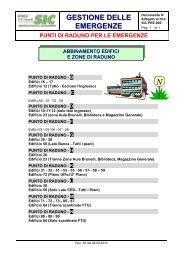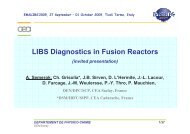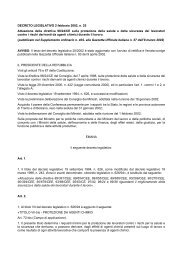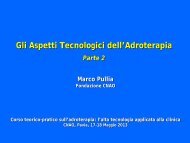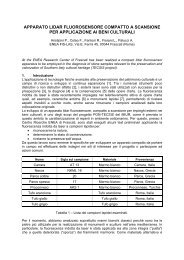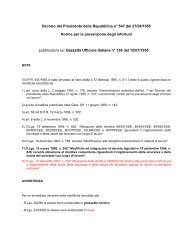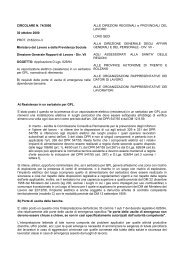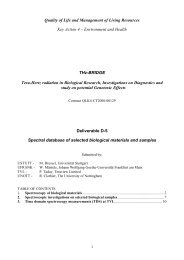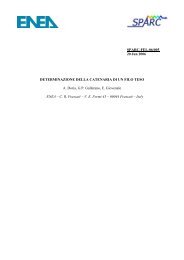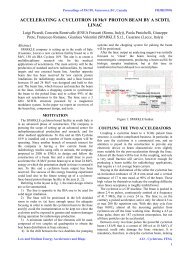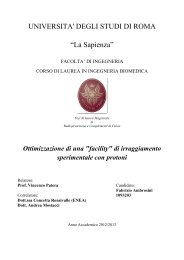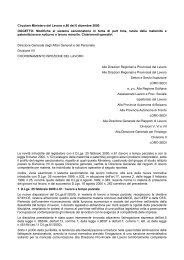Theory, Design and Tests on a Prototype Module of a Compact ...
Theory, Design and Tests on a Prototype Module of a Compact ...
Theory, Design and Tests on a Prototype Module of a Compact ...
Create successful ePaper yourself
Turn your PDF publications into a flip-book with our unique Google optimized e-Paper software.
2. ANALYSIS OF COUPLED CAVITIES 27<br />
2. Analysis <strong>of</strong> Coupled Cavities<br />
In this secti<strong>on</strong> we deal with the study <strong>of</strong> the properties <strong>of</strong> a res<strong>on</strong>ant<br />
cavities chain. From the previous step <strong>on</strong>e obtains the frequency <strong>of</strong><br />
feeding 1 , that has to be the res<strong>on</strong>ant frequency <strong>of</strong> the whole chain <str<strong>on</strong>g>and</str<strong>on</strong>g><br />
the shunt impedance for the accelerating cavities. The quality factor<br />
<strong>of</strong> the cavities can be assigned from the used material <str<strong>on</strong>g>and</str<strong>on</strong>g> the foreseen<br />
roughness <strong>of</strong> surfaces; <strong>of</strong> course after the design <strong>of</strong> cavities, a feedback<br />
is necessary to c<strong>on</strong>trol the results with the real values.<br />
In this step, the value <strong>of</strong> the coupling coefficient between cavities<br />
could be chosen. This parameter has a fundamental role since it determines<br />
the separati<strong>on</strong> between res<strong>on</strong>ant modes <strong>of</strong> the chain <str<strong>on</strong>g>and</str<strong>on</strong>g> the<br />
power flow through the chain. The undesirable coupling coefficient<br />
between n<strong>on</strong>-adjacent accelerating cavities <str<strong>on</strong>g>and</str<strong>on</strong>g> between n<strong>on</strong>-adjacent<br />
coupling cavities has to be c<strong>on</strong>sidered too. Its value could be supposed<br />
known <str<strong>on</strong>g>and</str<strong>on</strong>g> stated to percent fracti<strong>on</strong>s <str<strong>on</strong>g>and</str<strong>on</strong>g> obtained later during the<br />
single cavities design.<br />
The aim <strong>of</strong> the analysis is to verify the correct behavior <strong>of</strong> the axial<br />
electric field, which is the accelerating field, taking into account the<br />
machining tolerance. The latter is represented through errors in the<br />
cavities parameters.<br />
It is apparent that for this analysis it is sufficient a lumped single<br />
mode res<strong>on</strong>ant circuit to describe each cavity, rather then a detailed<br />
3-D descripti<strong>on</strong> <strong>of</strong> each cavity. Different approaches are thinkable: <strong>on</strong>e<br />
can simulate the chain <strong>of</strong> equivalent circuits with an electric network<br />
simulator, <str<strong>on</strong>g>and</str<strong>on</strong>g> we follow this way in the next secti<strong>on</strong>, by using Spice,<br />
or <strong>on</strong>e can use a semi-analytical approach, by means <strong>of</strong> matrices representati<strong>on</strong>s,<br />
<str<strong>on</strong>g>and</str<strong>on</strong>g> study the effects <strong>of</strong> tolerances using the perturbati<strong>on</strong>s<br />
theory, <str<strong>on</strong>g>and</str<strong>on</strong>g> we follow this sec<strong>on</strong>d way in the next chapter.<br />
2.1. Equivalent circuit for res<strong>on</strong>ant coupled cavities. Let us<br />
start from the bricks <strong>of</strong> which are made the equivalent model we want<br />
to present. A microwave cavity res<strong>on</strong>ating at a certain frequency can be<br />
represented using an equivalent lumped circuit [12] with a resistance,<br />
an inductance <str<strong>on</strong>g>and</str<strong>on</strong>g> a capacitance. Each <strong>of</strong> them represent an effect: the<br />
inductance represents the magnetic energy stored in the cavity volume,<br />
the capacitance represents the str<strong>on</strong>g electric field effect around the<br />
typical noses for n<strong>on</strong>-relativistic particles <str<strong>on</strong>g>and</str<strong>on</strong>g> the resistance represents<br />
the ohmic losses <strong>on</strong> the cavity walls.<br />
The R, L <str<strong>on</strong>g>and</str<strong>on</strong>g> C parameters are also related with the res<strong>on</strong>ant frequency,<br />
the quality factor expressed by the formula (2.3) <str<strong>on</strong>g>and</str<strong>on</strong>g> with the<br />
shunt impedance expressed by the formula (2.4). The relati<strong>on</strong>s are the<br />
1 Thanks to the power generator, namely the klystr<strong>on</strong>, it is usually a narrow<br />
b<str<strong>on</strong>g>and</str<strong>on</strong>g> <strong>of</strong> frequencies, rather then a single t<strong>on</strong>e.



